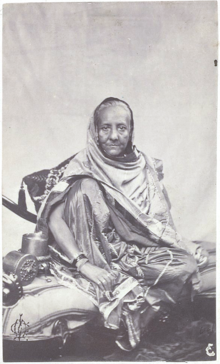Zeenat Mahal
| Zeenat Mahal | |
|---|---|
| Empress consort of the Mughal Empire Begum Sahiba | |
 Zeenat Mahal's supposed only known photograph, possibly the only photograph that exists of any Mughal empress | |
| Padshah Begum | |
| Tenure | 19 November 1840 – 14 September 1857 |
| Predecessor | Badshah Begum |
| Successor | position abolished |
| Born | 1823 |
| Died | 17 July 1886 (aged 62–63) Rangoon, British Burma |
| Burial | Near the Mazar of Bahadur Shah, No. 6 Theatre Road, Yangon, Myanmar |
| Spouse | |
| Issue | Mirza Jawan Bakht |
| House | Timurid |
Zeenat Mahal (1823 – 17 July 1886) was the only wife and de facto regent of the Mughal Kingdom on behalf of her husband, the Mughal emperor Bahadur Shah Zafar.
Biography[edit]
Zeenat Mahal married Bahadur Shah II at Delhi on 19 November 1840 and had a son with him, Mirza Jawan Bakht.
She greatly influenced the emperor and, after the death of crown prince Mirza Dara Bakht, she began promoting her son Mirza Jawan Bakht as heir to the throne over the Emperor's remaining eldest son Mirza Fath-ul-Mulk Bahadur. But due to the primogeniture policy of the British, this was not accepted.[1] She was suspected of poisoning the British Resident in Delhi, Thomas Metcalfe, in 1853 for meddling too much in palace affairs.[2]

She resided at her own haveli, Zeenat Mahal, in Lal Kuan, old Delhi.[3][4]
1857 rebellion[edit]
During the Indian rebellion of 1857, she kept her son out of contact with the rebels in an attempt to secure the throne for him. With the British victory, the emperor's two other sons were shot for supporting the rebels; however, her son did not become heir. In 1858, her husband was deposed by the British, bringing the Mughal empire to an end, and she was exiled to Rangoon with her husband. After her husband's death in 1862, the British banned anyone from claiming the title of Emperor in an attempt to dissolve the monarchy.
Death[edit]
She died on 17 July 1886.[citation needed] Another source says that she "died more than 20 years after her husband."[5] She was buried in her husband's tomb in Yangon's Dagon Township near the Shwedagon Pagoda. The site later became known as Bahadur Shah Zafar Dargah.[6][7]
The grandchild of her and Bahadur Shah II is also buried alongside the couple.[8] After remaining lost for many decades, the tomb was discovered during a restoration exercise in 1991.[8]
Gallery[edit]
-
Kabin-name (Marriage Certificate) of Bahadur Shah and Zeenat Mahal
-
A portraiture of Zeenat Mahal
-
A portraiture of Zeenat Mahal
-
A portraiture of Zeenat Mahal
-
Zeenat Mahal's tomb in Yangon
-
Zeenat Mahal's haveli at Lal Kuan in Old Delhi
See also[edit]
References[edit]
- ^ Metcalf, Barbara Daly; Metcalf, Thomas R. (2012). A concise history of modern India (3rd ed.). Cambridge, England: Cambridge University Press. ISBN 9781139526494. OCLC 808342004.
- ^ The Hindu : A case of Delhi poisoning?
- ^ Smith, R. v. (16 October 2011). "The sad plight of Zeenat Mahal". The Hindu.
- ^ "The ruined haveli of Zeenat Mahal".
- ^ Smith, R. v. (16 October 2011). "The sad plight of Zeenat Mahal". The Hindu.
- ^ "PM to pay homage to last Mughal emperor". Daily News. 27 May 2012. Archived from the original on July 12, 2012. Retrieved 27 May 2012.
- ^ Sattar Kapadia. "Bahadur Shah Zafar Dargah". kapadia.com. Archived from the original on 25 October 2012. Retrieved 12 January 2014.
- ^ a b "PM visits Bahadur Shah Zafar's memorial in Myanmar". CNN-IBN. May 29, 2012. Archived from the original on October 13, 2012.
External links[edit]
![]() Media related to Zinat Mahal at Wikimedia Commons
Media related to Zinat Mahal at Wikimedia Commons
- The Prime Minister at Bahadur Shah Zafar's Dargah (Video) at CNN-IBN, May 30, 2012.






